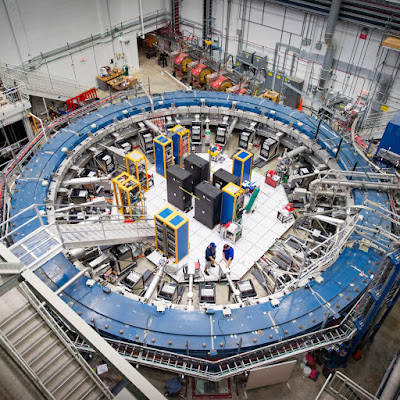“Evidence is mounting that a tiny subatomic particle seems
to be disobeying the known laws of physics, scientists announced on Wednesday
[April 7], a finding that would open a vast and tantalizing hole in our
understanding of the universe.
“The result, physicists say, suggests that there are forms
of matter and energy vital to the nature and evolution of the cosmos that are
not yet known to science. The new work, they said, could eventually lead to
breakthroughs more dramatic than the heralded discovery in 2012
of the Higgs boson, a particle that imbues other particles with
mass.
“‘This is our Mars rover landing moment,’ said Chris Polly,
a physicist at the Fermi National Accelerator Laboratory, or Fermilab, in
Batavia, Ill., who has been working toward this finding for most of his career.
“The particle célèbre is the muon, which is akin to an
electron but far heavier, and is an integral element of the cosmos. Dr. Polly
and his colleagues — an international team of 200 physicists from seven
countries — found that muons did not behave as predicted when shot through an
intense magnetic field at Fermilab.
“‘The aberrant behavior poses a firm challenge to the
Standard Model, the suite of equations that enumerates the fundamental
particles in the universe (17, at last count) and how they interact. This is
strong evidence that the muon is sensitive to something that is not in our best
theory,’ said Renee Fatemi, a physicist at the University of Kentucky.
“The results, the first from an experiment called Muon g-2,
agreed with similar experiments at the Brookhaven National Laboratory in 2001
that have teased physicists ever since. ‘After 20 years of people wondering
about this mystery from Brookhaven, the headline of any news here is that we
confirmed the Brookhaven experimental results,’ Dr. Polly said.
“At a virtual seminar and news conference on Wednesday,
Dr. Polly pointed to a graph displaying white space where the Fermilab findings
deviated from the theoretical prediction. ‘We can say with fairly high
confidence, there must be something contributing to this white space,’ he said.
What monsters might be lurking there?
“‘Today is an extraordinary day, long awaited not only
by us but by the whole international physics community,’ Graziano Venanzoni, a
spokesman for the collaboration and a physicist at the Italian National
Institute for Nuclear Physics, said in a statement issued by Fermilab. The
results are also being published in a set of papers submitted to Physical Review Letters, Physical Review A, Physical Review D and
Physical Review Accelerators and Beams.
“The measurements have about one chance
in 40,000 of being a fluke, the scientists reported, well short of the gold
standard needed to claim an official discovery by physics standards. Promising
signals disappear all the time in science, but more data are on the way. Wednesday’s
results represent only 6 percent of the total data the muon experiment is
expected to garner in the coming years.
“For decades, physicists have relied
on and have been bound by the Standard Model, which successfully explains the
results of high-energy particle experiments in places like CERN’s Large Hadron
Collider. But the model leaves many deep questions about the universe
unanswered.
“Most physicists believe that a rich trove of new physics
waits to be found, if only they could see deeper and further. The additional
data from the Fermilab experiment could provide a major boost to scientists
eager to build the next generation of expensive particle accelerators.
“It might also lead in time to explanations for the kinds of
cosmic mysteries that have long preoccupied our lonely species. What exactly is dark matter,
the unseen stuff that astronomers say makes up one-quarter of the universe by
mass? Indeed, why is there matter in the
universe at all?...” (Dennis Overbye, New York Times).


No comments:
Post a Comment
Note: Only a member of this blog may post a comment.